This week, we find out how artificial DNA could tell us about the origins of life, discover a way to identify those most at risk of bowel cancer and explore a new treatment for TB. Plus, we find out what happened this week in science history...
In this episode
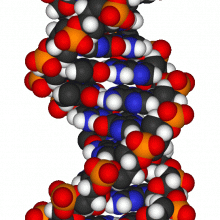
It’s Alive – Artificial DNA
Scientists have turned the basic structure of DNA on its head: taking it from 4 bases to 12.
This 12 base system has already been implemented in developing new forms of personalised medicine but now the researchers want to see if this more complex DNA can be self-sustaining.
Fifty-six years ago, Watson and Crick described DNA as containing base pairs made up of adenine, thymine, guanine and cytosine or A-T-G and C.
As far as we know, all DNA on Earth uses only these four bases (before methylation) and RNA uses uracil in place of thymine. But now Steve Benner, and colleagues from Florida, have re-written these rules and his group are testing a system that uses eight more bases.
They hope the research will shed light on how life started on Earth, by producing a self-sustaining molecule capable of Darwinian evolution and reproduction. And it's similar to the one that is thought to have appeared on Earth nearly four billion years ago.
At the American Chemical Society meeting this week, Benner described his ultimate goal to synthesize a similar molecule in his lab at the Foundation for Applied Molecular Evolution. His 12 letter genetic system is capable of nearly all of the actions that define a living thing -- reproduction, growth and response to its environment.
"But it still isn't self-sustaining," Benner explained. "You need a graduate or post-doc to come in the morning and feed it. It doesn't look for its own food. No one has gotten that first step to work. If you start making estimates of how many molecules you have to look for in order to find one that does this, you're talking about 1 x 10^34 molecules."
It sounds like something from the X-files, but one day they may grow their very own alien DNA molecule in the lab.
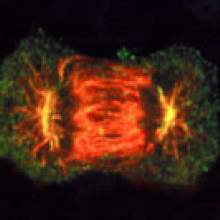
Test to Identify Relatives at Risk
 The key to treating cancer successfully is catching it as early as possible. This is particularly true in the case of bowel cancer, where around eight out of ten people will survive if their cancer is caught at an early stage, but sadly only about one in ten cancers are actually caught this early.
The key to treating cancer successfully is catching it as early as possible. This is particularly true in the case of bowel cancer, where around eight out of ten people will survive if their cancer is caught at an early stage, but sadly only about one in ten cancers are actually caught this early.
We already know from research that having a family history of bowel cancer increases the risk of developing the disease yourself - for example, just having one first degree relative with the disease can double your risk - that's a parent, sibling or child. And if they were diagnosed young, under the age of 45, this increases your own chances even more.
Previous research has suggested that offering colonoscopy screening people from families with a strong family history of bowel cancer could help to save lives. But it's not practically possible to screen everyone with one relative with the disease.
Now research from Cancer Research UK-funded scientists at the Institute of Cancer Research in Surrey has shown that a simple test could help to identify people with bowel cancer whose immediate relatives are at highest risk of developing the disease.
The scientists studied DNA in tumour samples taken from nearly 3,000 people with bowel cancer. They were looking for signs of microsatellite instability, which is basically messed-up DNA. This happens when there are faults in genes that repair DNA.
The researchers found that first degree relatives of patients whose tumours showed microsatellite instability were much more likely - up to twenty times more - to develop cancer themselves than relatives of patients whose tumours didn't show the instability, particularly if the patient developed cancer under the age of 45.
Overall, the scientists suggest that it would be worth screening people from the age of 25 from families where someone young develops bowel cancer with microsatellite instability. But people related to patients whose tumours don't have microsatellite instability wouldn't need screening from such a young age. This would help to target stretched screening resources to people at greatest risk, and also help to avoid having to screen people unnecessarily.
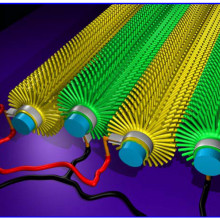
Truly Juicy Couture
Charging your mobile phone could be done just by waving your arms and legs about a bit, according to scientists in the US. Zhong Lin Wang and colleagues have used millions of nanowires made from zinc oxide to generate electric currents from simple body movements, such as walking or even the flow of blood around your body. And the researchers say this technology could negate the need for batteries in the future.
 Presented at the American Chemical Society meeting this week, Wang described how these nanowires are piezo-electric, which means every time they are subjected to mechanical stress they produce a current.
Presented at the American Chemical Society meeting this week, Wang described how these nanowires are piezo-electric, which means every time they are subjected to mechanical stress they produce a current.
Now, last year the researchers placed a nanowire generator in a bio-fluid, passed ultrasonic waves through it and the movement produced a small, but detectable direct current. This time the researchers say that making the nanowires out of zinc oxide means they can generate electricity from much lower-frequency movements. And that includes waving your arms about or the effects of a soft breeze on a fabric. The nanogenerators are made by growing these zinc oxide wires radially around conductive fibres.
They say they do need quite a lot of these nanogenerators to make enough current to run something like a mobile phone. But, the zinc oxide nanowires can actually be grown on all sorts of different surfaces such as metals, ceramics or even clothing. And the wires are only 1/25th the diameter of a human hair so theoretically you could incorporate them into a t-shirt - and they'd remain virtually invisible.
What's even more exciting is that these energy materials generate current in air and in water so, as long as the device you want to charge is waterproof, you can give it some juice while you're swimming.
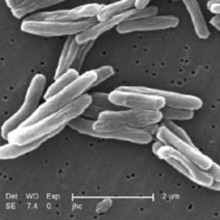
Structural studies shed light on TB treatments
 Tuberculosis, or TB, is a growing problem around the world, and it's on the rise in Western countries as well as in the developing world - it's thought that someone somewhere is being infected with TB every single second. Now researchers in the US have made a discovery that could help scientists to develop new drugs to tackle this growing problem.
Tuberculosis, or TB, is a growing problem around the world, and it's on the rise in Western countries as well as in the developing world - it's thought that someone somewhere is being infected with TB every single second. Now researchers in the US have made a discovery that could help scientists to develop new drugs to tackle this growing problem.
Current TB treatments only tackle actively growing bacteria - the Mycobacterium tuberculosis that cause the disease. But these bugs can also lie low in the body - a property called latency - making them difficult to treat effectively. It's thought that around a third of the world's population has a latent infection with Mycobacterium tuberculosis, and one in ten of these will go on to develop full-blown TB.
Led by Barbara Gerratana at the University of Maryland, the researchers uncovered the molecular structure and mechanism of an enzyme called NAD+ synthetase, which plays an important role in the TB bacterium's energy production by producing a chemical called NAD+.
It's an important drug target, because while humans use many different molecular pathways to produce NAD+, the TB bacteria only use two, and they both rely on NAD+ synthetase. And the enzyme is still needed even if the bacteria are lying low, or latent. So knocking out the action of this enzyme using drugs could be a powerful and specific way to treat TB infections, including latent infections.
The researchers used a technique called X-ray crystallography to find the structure of NAD+ synthetase at an atomic scale. High-energy X-ray beams are fired through crystals made of the enzyme, and the resulting image is analysed by computer to reveal the structure.
Now we have this structure, it's going to be possible to rationally design drugs that specifically fit into crucial parts of the enzyme and block its activity. So it's a big step forward in the fight against TB infection.
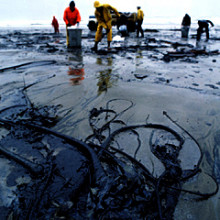
09:54 - This Week in Science History - The First Genetic Patent
This Week in Science History - The First Genetic Patent
Sarah Castor-Perry
This week in science history, in 1981, saw the issuing of a patent to Ananda Mohan Chakrabarty for a genetically modified Pseudomonas bacterium that would eat up oil spills, the first patent of its kind.
 This was not the first bacterium to be engineered to do something that would be of use to humans - in 1978, Herbert Boyer engineered an E. coli bacterium that would produce human insulin, revolutionising and hugely improving treatment for diabetes - human insulin being much more effective than pig insulin, which was being used at the time.
This was not the first bacterium to be engineered to do something that would be of use to humans - in 1978, Herbert Boyer engineered an E. coli bacterium that would produce human insulin, revolutionising and hugely improving treatment for diabetes - human insulin being much more effective than pig insulin, which was being used at the time.
So the really important thing about this granting of the patent to Chakrabarty was not the fact that this group had modified an organism that would clean up oil spills, but that it set the precedent for the ability to get a patent for an animal or organism that had been genetically modified.
This was after a lengthy court case in 1980 that went right up to the Supreme Court of the United States, where the opposers to Chakrabarty's application for the patent argued that according to the United States constitution, living organisms could not be patented. The team defending Chakrabarty argued that the fact that the bacteria were living organisms was irrelevant, as it also states in the constitution that any novel process or technology created by man could be patented, and that this being a new species of bacteria, created by man, fell into this category. The Court ruled in Chakrabarty's favour.
There are 4 species of oil eating bacteria in the genus Pseudomonas, each using a different component of the oil as a food source, but when added to a sample of oil together, they compete with each other - like any four species would do if all put together with a food source that they all want to eat. This meant that the oil wasn't cleaned up very efficiently or very quickly.
 Bacteria contain plasmids, rings of DNA that code for the proteins they produce. Differences in this DNA will lead to proteins allow the bacteria to use oil, methane, sugar, sulphur or many other things as food. Chakrabary's team took the plasmids from the four species of oil-eating bacteria and put them all into a single bacteria. Usually these plasmids would not all cooperate in the same cell, but exposing the cell to ultraviolet light made the plasmids join into one that could use all 4 pathways of the original plasmids to break down several different components of oil.
Bacteria contain plasmids, rings of DNA that code for the proteins they produce. Differences in this DNA will lead to proteins allow the bacteria to use oil, methane, sugar, sulphur or many other things as food. Chakrabary's team took the plasmids from the four species of oil-eating bacteria and put them all into a single bacteria. Usually these plasmids would not all cooperate in the same cell, but exposing the cell to ultraviolet light made the plasmids join into one that could use all 4 pathways of the original plasmids to break down several different components of oil.
[CORRECTION - Ed]Due to concerns at the time about releasing genetically modified organisms into the environment, Chakrabarty's team decided to test the use of just the oil-degrading compounds, called biosurfactants, that the bacteria make. The Pseudomonas biosurfactants proved effective against the oil of the disastrous Exxon Valdez spill in 1989 in a test carried out by Chakrabarty, but was not used in the field, despite the tests also showing that the bacterial oil-degrading compounds were much less toxic than synthetic ones already in use. Professor Chakrabarty still hopes that his Pseudomonas surfactants will be used in oil spills one day.
Many other genetically engineered organisms have been patented since then, from bacteria used in mineral extraction up to mice and rats used to study genetic disorders, known as knock-outs. The ability to engineer the genomes of organisms has had huge medical, industrial and environmental benefits, but it still remains controversial, especially in agriculture.
Related Content
- Previous Deadly Snakes
- Next History of Medicine










Comments
Add a comment